
upload photo | donate | calendar
 |
my profile |
register |
faq |
search upload photo | donate | calendar |
|
|
#11 |
|
User
Join Date: Oct 2007
Location: Maryland
Posts: 365
Thanks: 48
Thanked 136 Times in 60 Posts
|
Here we have the left side of the receiver showing the magazine well with its doors closed:
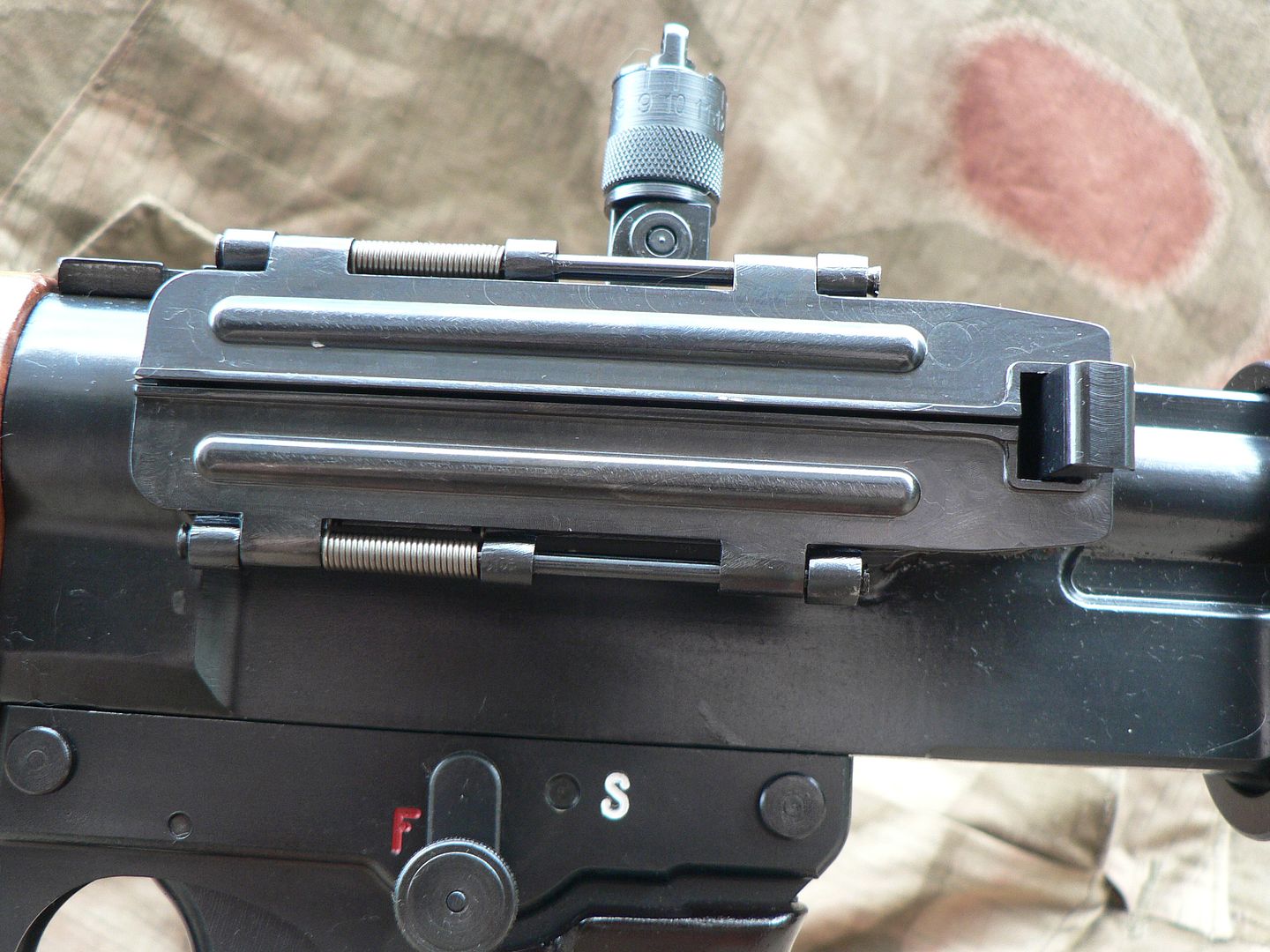 The convex hump running horizontally along each door is a reinforcement rib placed there for rigidity. Since these doors are milled instead of stamped, they are probably not necessary but it looks more authentic. We can see that the long pins they pivot on have been mushroomed at each end to keep them from sliding out of their mounting collars and we can see the coil spring for each door too. Pressing the magazine catch forward enables the doors to snap open and fold themselves back over the magazine well. Inside we can see the bolt: 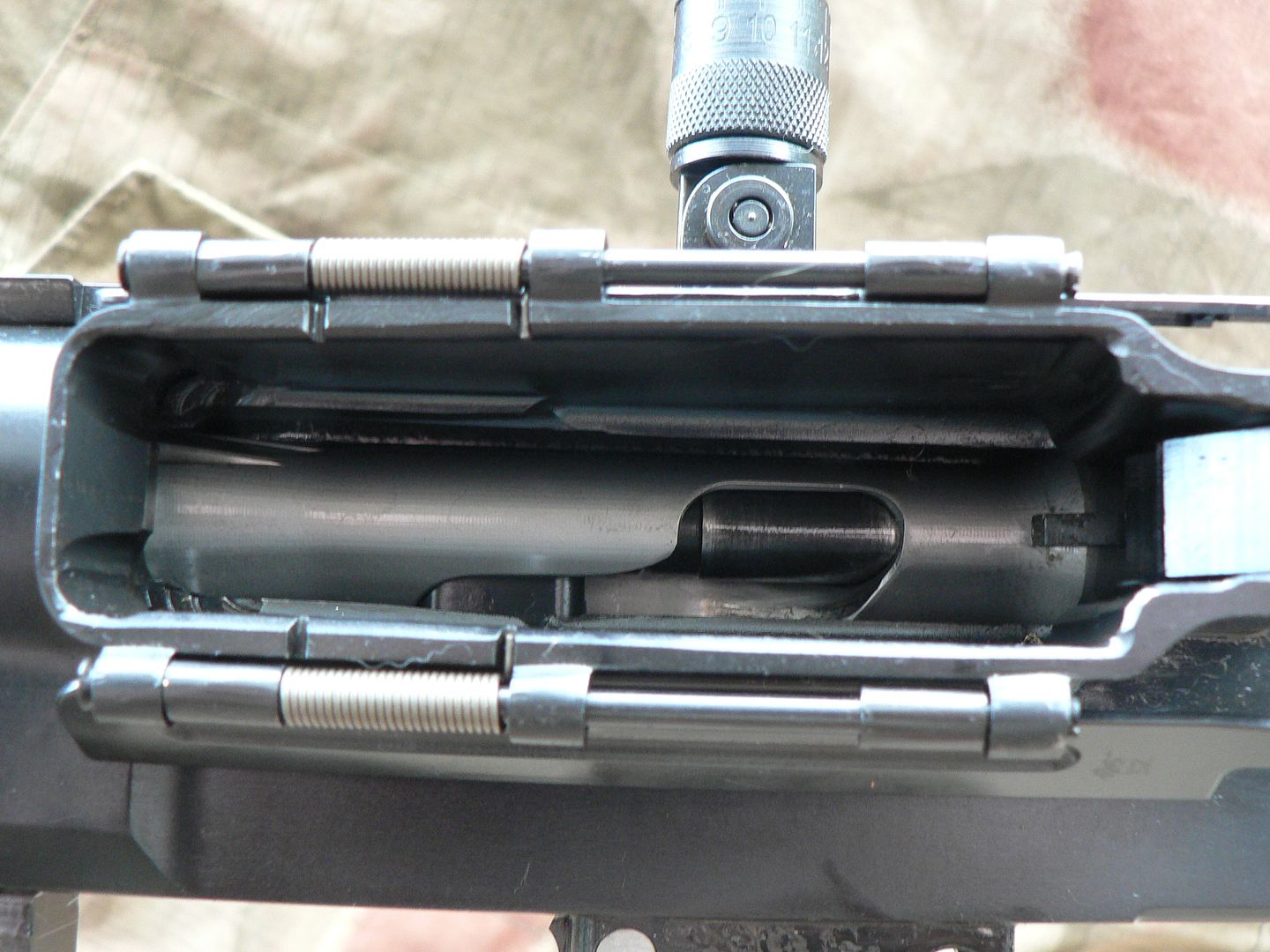 It looks like there's a lot of stuff going on in there!! It's not as much as it looks like though. The curved slot cutout of the silver/grey colored bolt is acted upon by the firing pin yoke (which is part of the bolt carrier) as it cycles back and forth during operation of the rifle. In this way, the yoke acts as a cam, causing the bolt to rotate along its axis thus unlocking and locking the action. At the front lower part of the slot, you can see a blued rectangle. This is the mentioned yoke that holds the firing pin and is part of the bolt carrier. At the upper rear of the slot we can see the firing pin spring guide. Currently, the rifle is not cocked. If it were cocked, the view inside the magazine well would look like this: 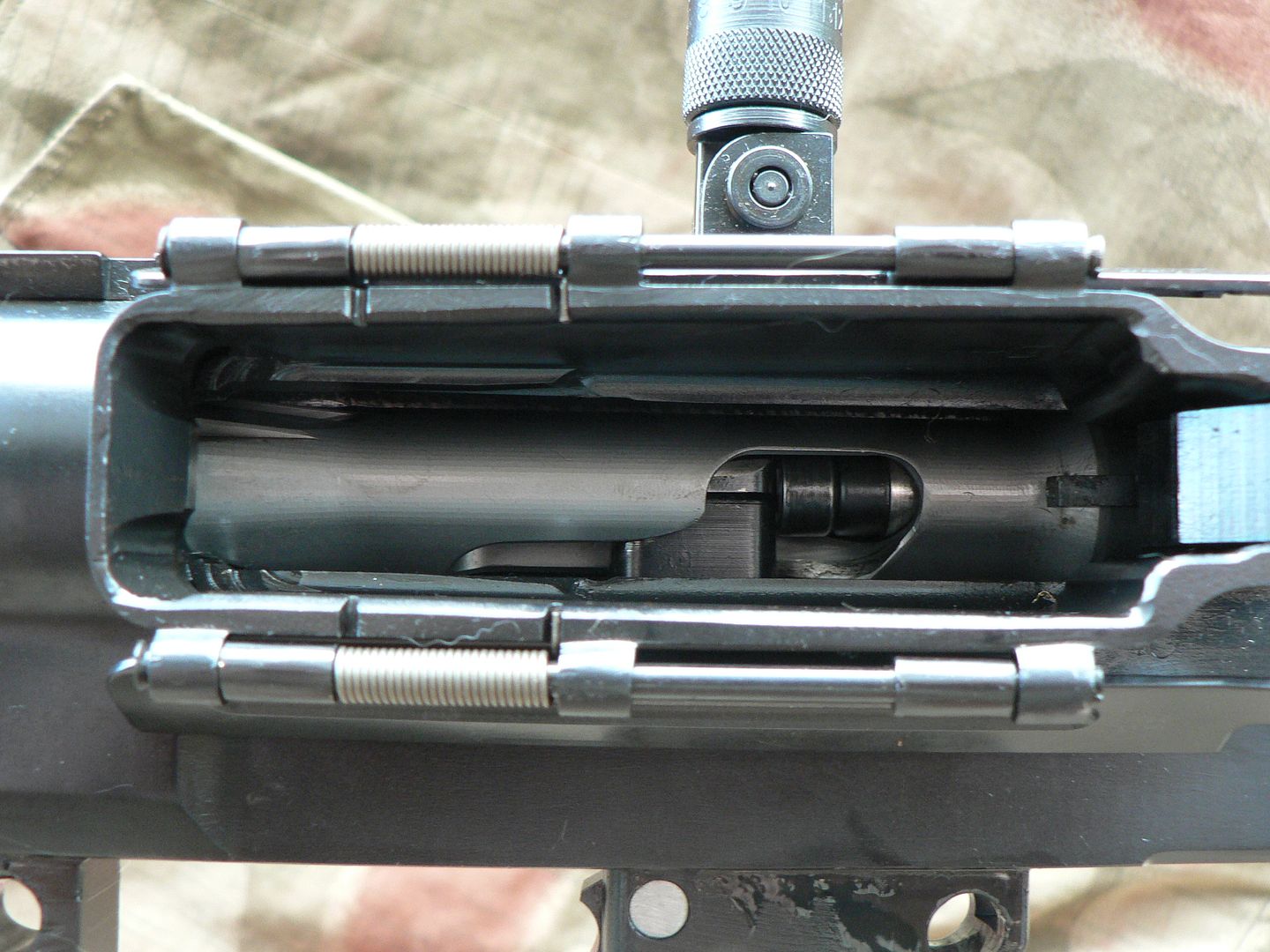 Notice that the bolt has not moved at all, neither rearward nor forward and it has not rotated. However, the firing pin yoke (and the entire bolt carrier for that matter because the yoke is just a machined part of the carrier) has moved to the rear a short distance. It is now seen in the middle of the bolt slot. Just behind the rear of the yoke is the rear of the firing pin and part of the firing pin spring guide. It is important to understand that, while this rifle is striker fired, it is not striker fired in the normal sense. The firing pin is securely held by the yoke on the bolt carrier and does not move on its own. Instead, the entire bolt carrier moves forward when the trigger is pulled, taking the firing pin along for the ride and slamming it into the primer on the cartridge case. This is accomplished by using two springs. One of the springs is the recoil spring. It is housed within the bolt carrier itself and cannot be seen until the rifle is disassembled. However, when the bolt carrier is this far forward, the recoil spring doesn't have much forward force left in it. To help out, there is a second spring hidden in the rear of the bolt. This spring is in a highly compressed state when the action is cocked. When the trigger is pulled, the force of these two springs combined is more than enough to set off the primer and ignite the charge. Get it? If not, check out a most excellent video on the FG42 done by Ian McCollum of forgotten weapons. In it, he describes the process better than I can. His video can be seen here with the description of the operation starting at the 5:47 mark: http://www.youtube.com/watch?v=jN4lvZbAe04 But we've gotten off track a little bit. Let's go back and look at the inside of the upper magazine well door opened up and laying against the top of the magazine well: 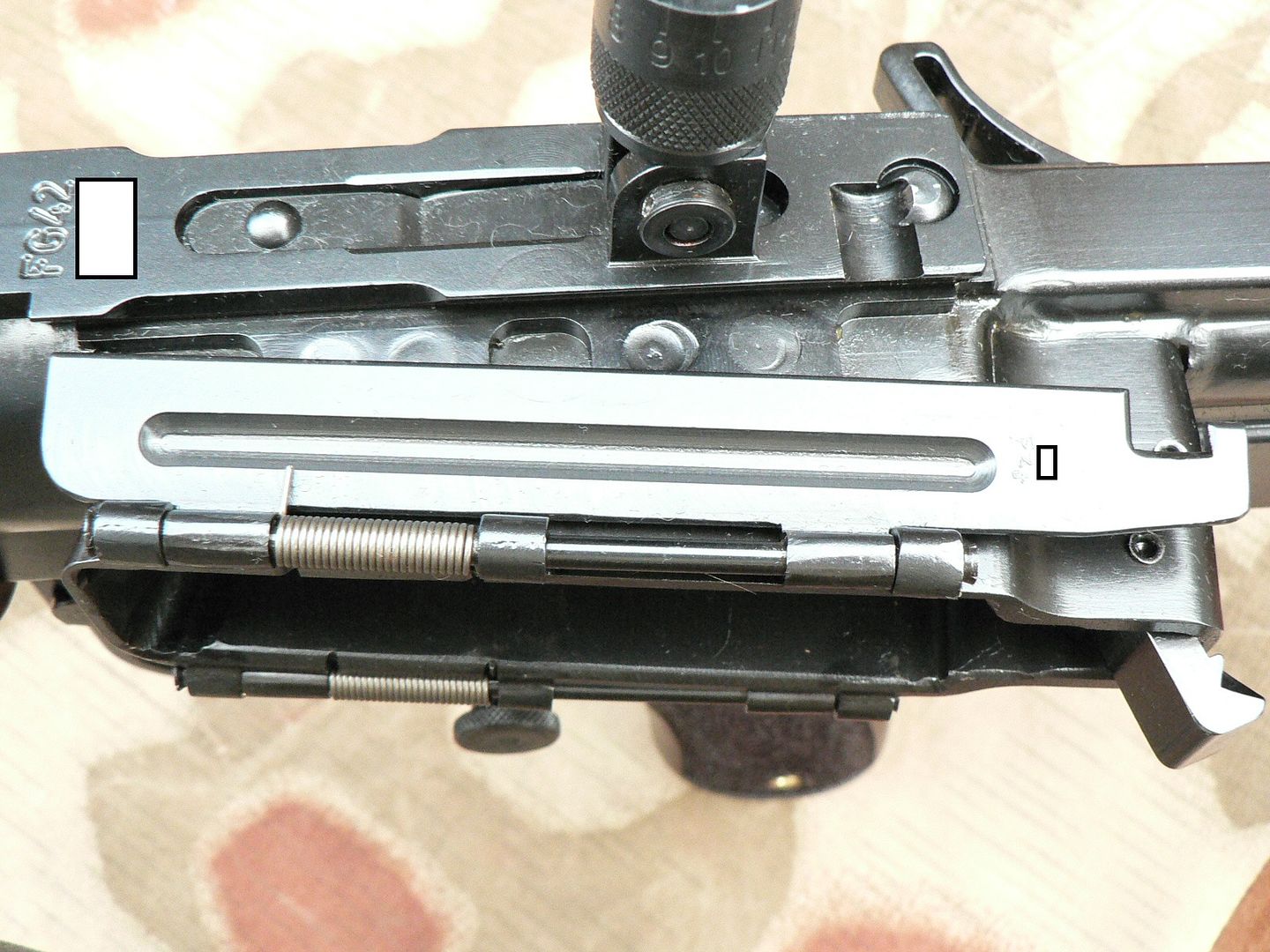 The glare in this picture is on purpose and is intended to showcase the door. Notice that it has a concave area running along its length to simulate the look of the reinforcement rib present on a stamped door. It's another instance of the many intricate details built into these rifles. Here's a close up showing the machining marks: 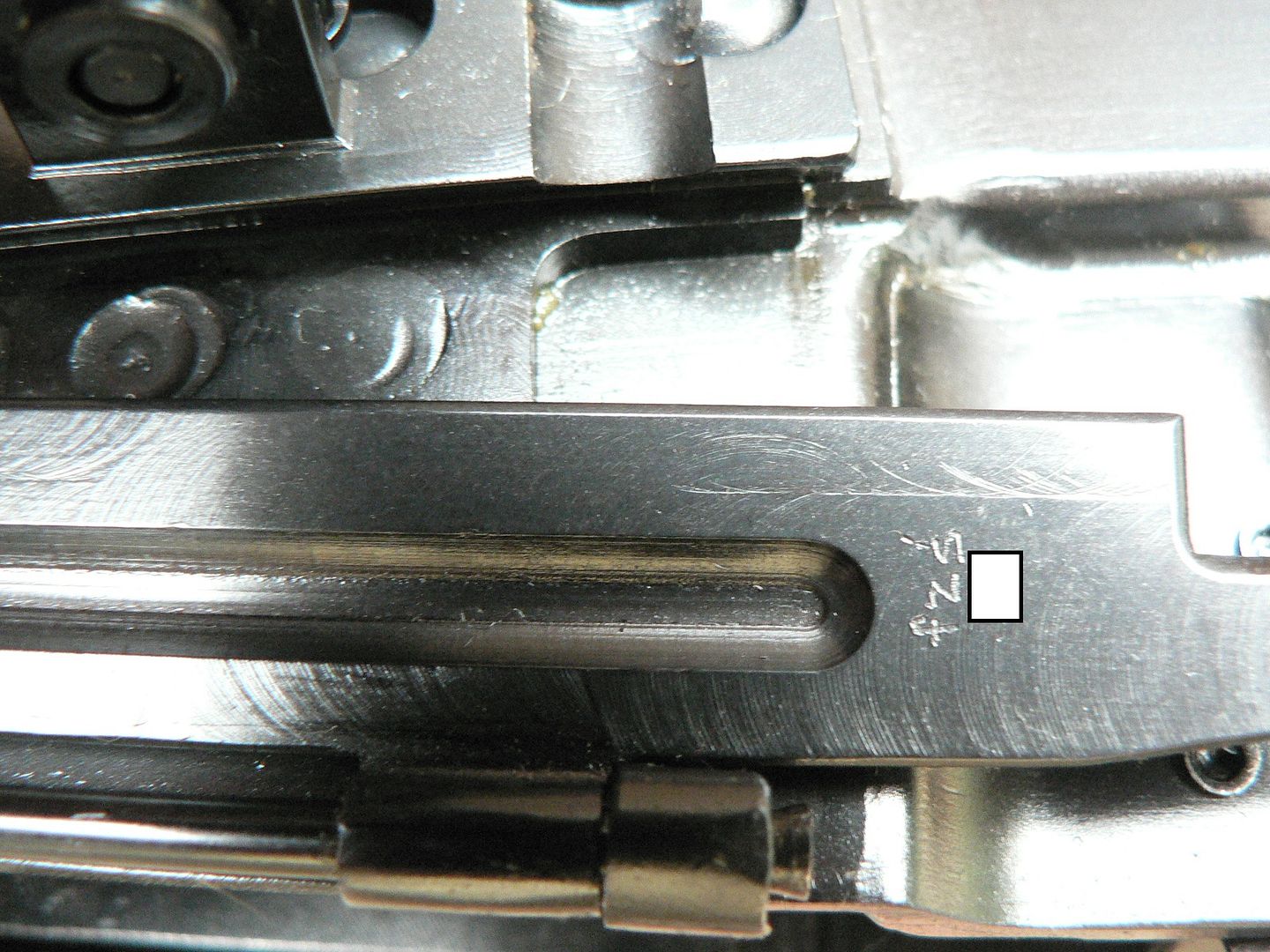 As stated earlier, the "fzs" mark would indicate Krieghoff manufacture and the white rectangle is covering up the serial number. The lower door is marked in a similar way. On to the bottom of the receiver. Here, we have removed the trigger housing assembly and the rifle is not cocked. Forward is to the right: 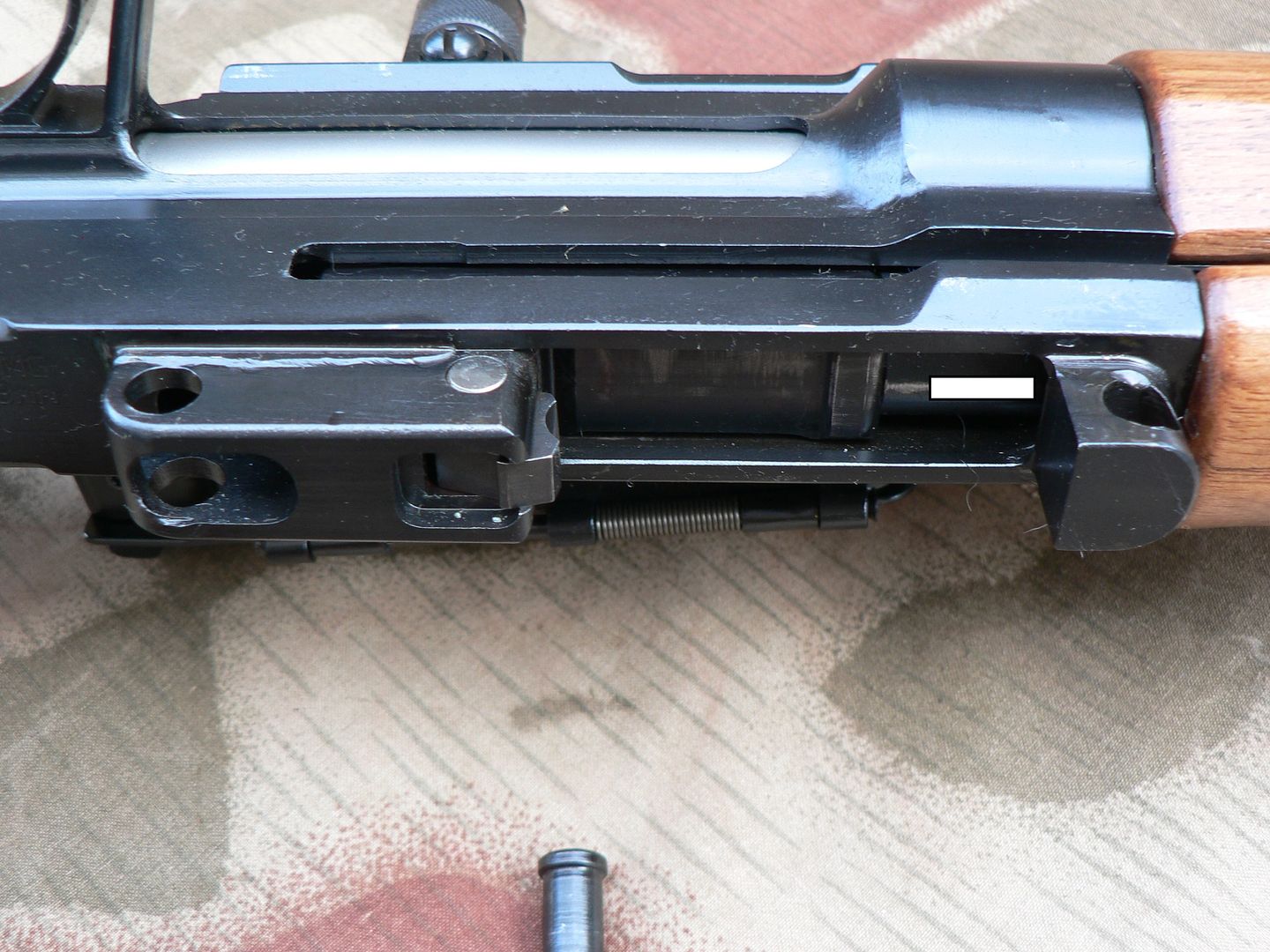 The rifle is laying on its left side and we can see the rear portion of the charging slot running along the right side of the receiver. The coiled spring is for the lower magazine well cover door and is mounted on the magazine well so it has nothing to do with the bottom of the receiver. To the right and just behind the hand guard is the front retaining pin lug for the trigger housing. The rear retaining pin lug is seen to the left of the picture. Moving forward of the rear retaining pin hole, the lug continues some distance until we see a bare metal pin passing through it. This holds the sear (which is seen at the front of the lug) in place. The sear trip in the trigger housing fits up into the square hole machined on the bottom of the lug and engages the catch on the bottom of the sear. As the trigger is pulled, the sear trip moves forward and rotates the sear counter-clockwise against spring tension when viewed from the right side of the rifle, pulling a catch machined on its upper surface (not seen) from engagement with a notch on the bottom of the bolt carrier allowing the carrier to run home and fire the round. The slot on the bottom of the bolt carrier can just barely be seen above the sear at the very front of the retaining pin lug. The white rectangle is covering up the serial number on the operating rod. Here is a shot showing the action cocked: 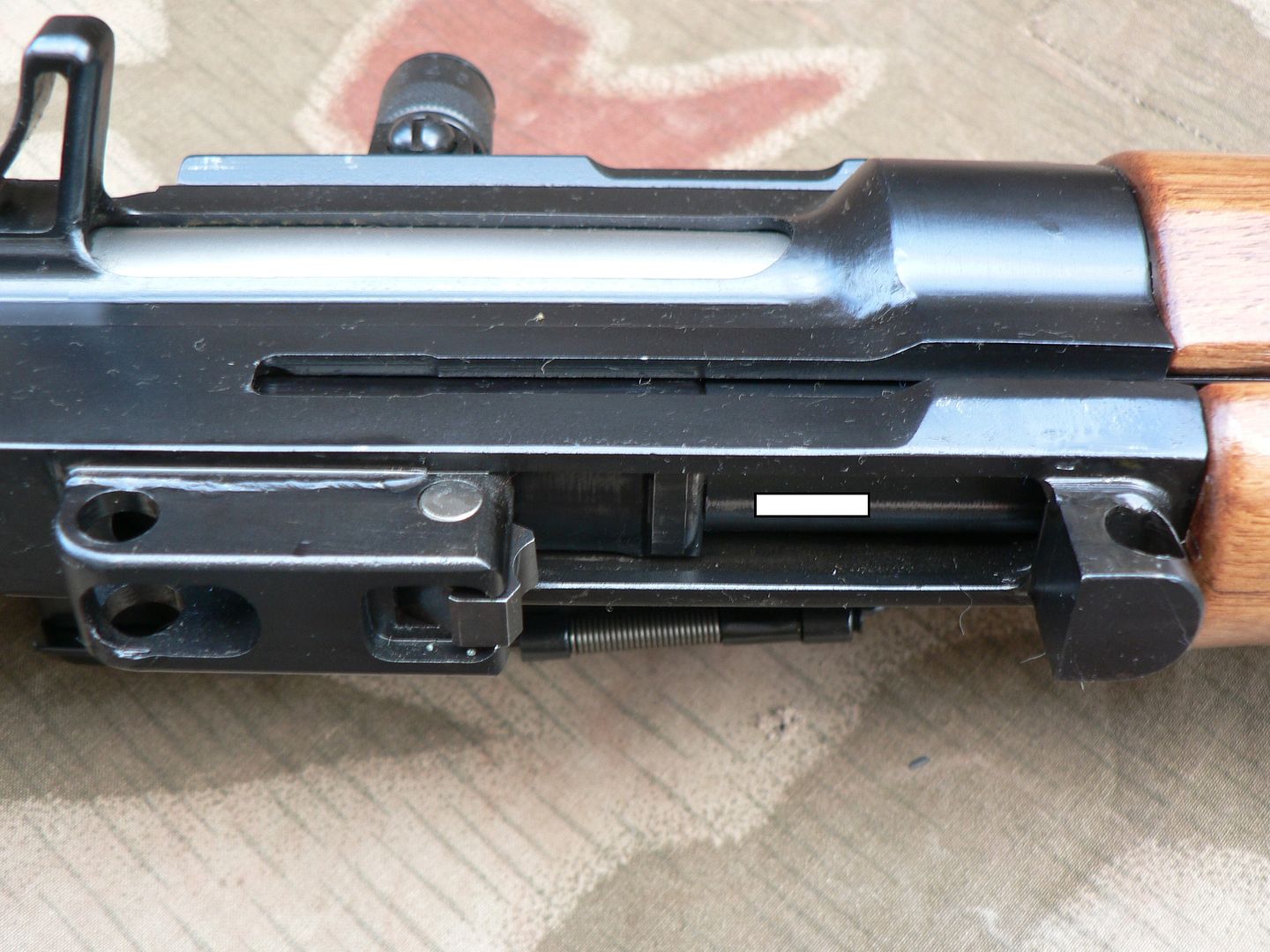 Notice that the bolt carrier has moved to the rear and the cocking notch on the bottom of it can no longer be seen. It is currently engaged by the catch on top of the sear. Behind the white rectangle covering the serial number is a blued rectangle running crossways in the receiver slot. This is where the bolt carrier ends and the operating rod begins. Here's a close-up of the sear area which better shows the cocking notch cut into the bottom of the bolt carrier: 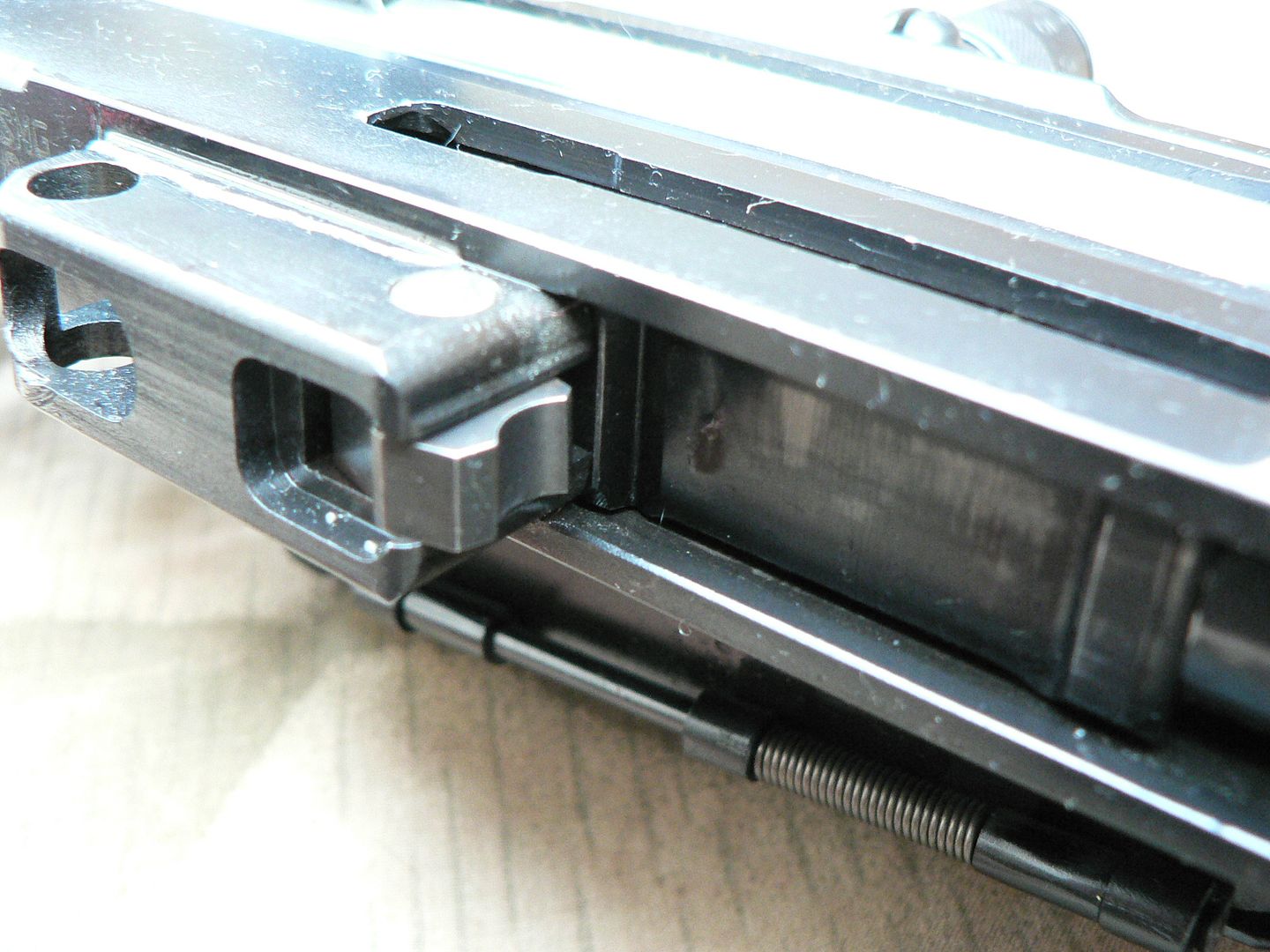 The dished out area on the front of the sear is where the disconnector lug fits. This receiver mounted sear arrangement is not present on original rifles and is part of the design modifications done to the ignition system in order to make it a purely semiautomatic only firearm. On original rifles, the fire control group is completely different in design and all parts are mounted within the trigger housing assembly. So how does the feel of the trigger pull on the SMG rifle differ from the German made FG42? I don't know at present but I will very soon because I'll be comparing my FG42 to an original bring back rifle. I will be taking notes and pictures which will be reported so be looking for that in the not too distant future. The only other thing of note on the bottom of the receiver is the Smith Manufacturing Group mark. It is placed on a flat area just behind the trigger housing and forward of the stock: 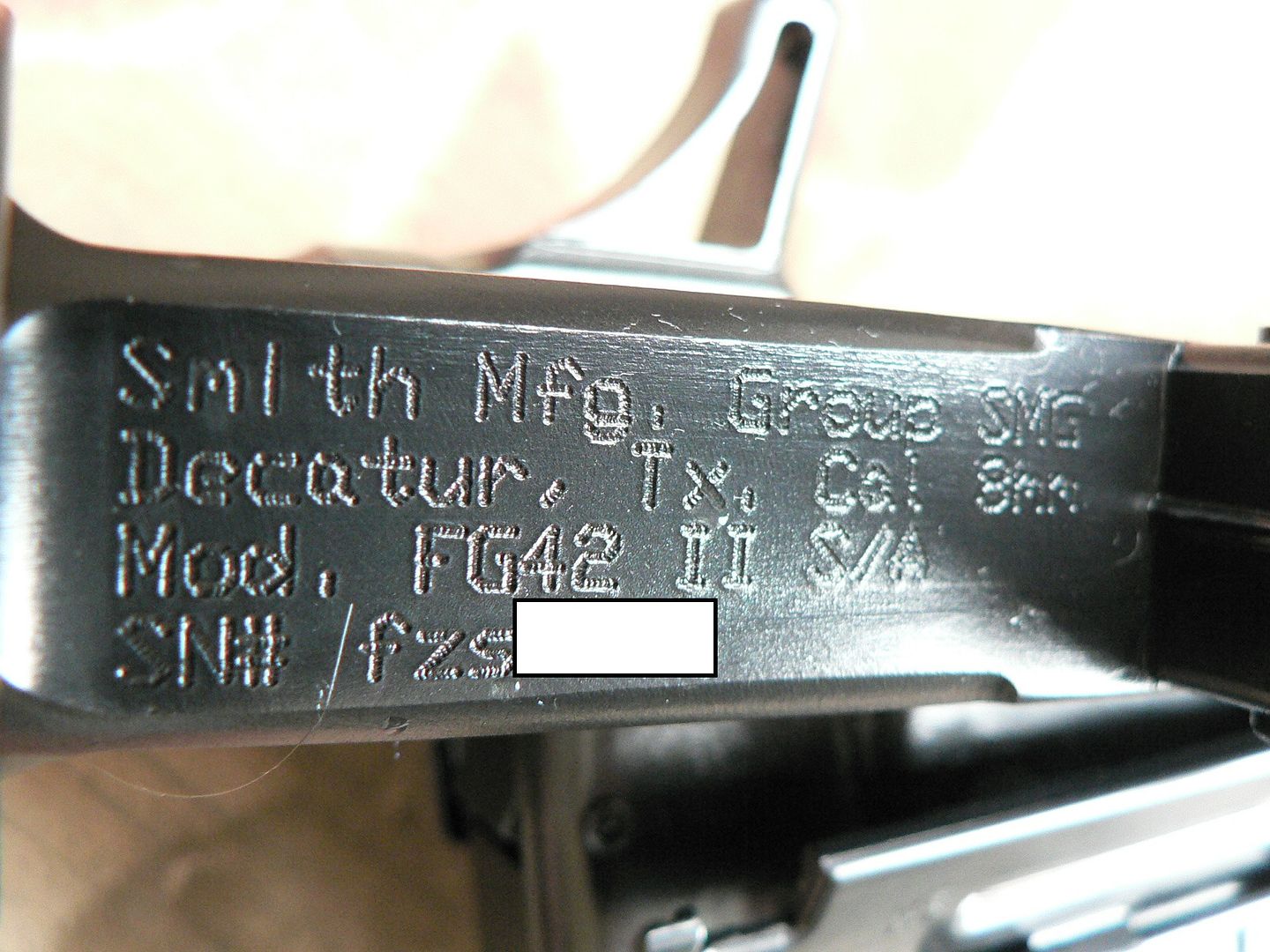 It appears to be electro-penciled. Not much to say here as it should be pretty self explanatory. As usual, the white rectangle is where the serial number is marked. It's nice that SMG placed it here on the bottom in a discreet area instead of emblazoning it along the side as some morons would most assuredly do........you know who you are! We're done for tonight but I'll be back at it soon. Last edited by Wilhelm; 09-30-2014 at 10:31 PM. |
|
|

|
|
|